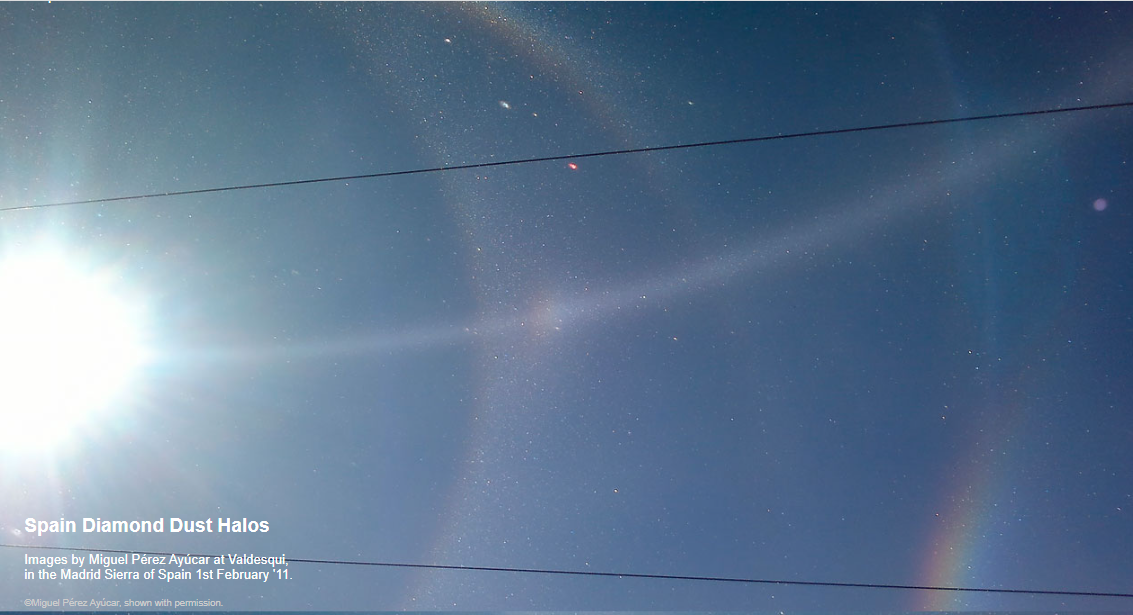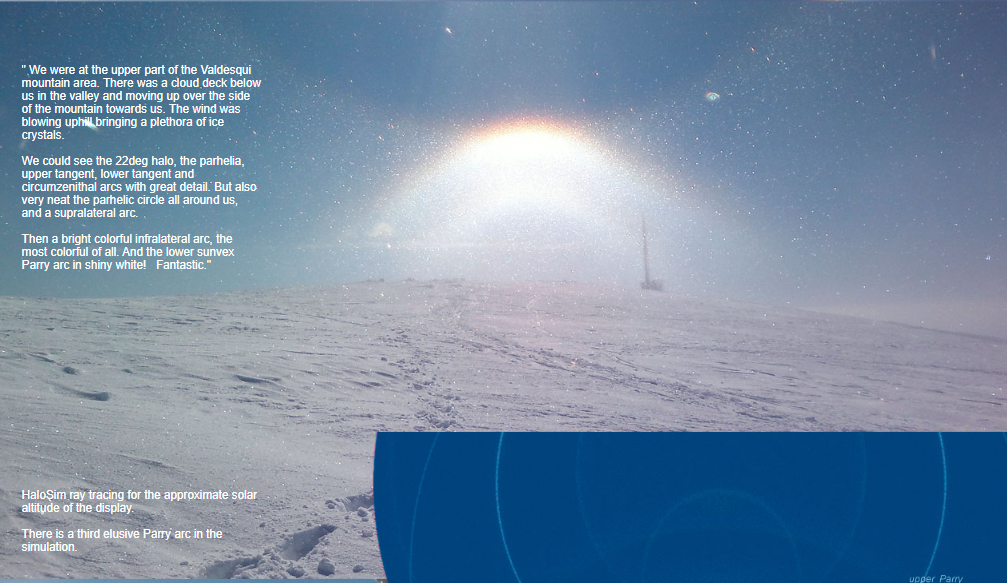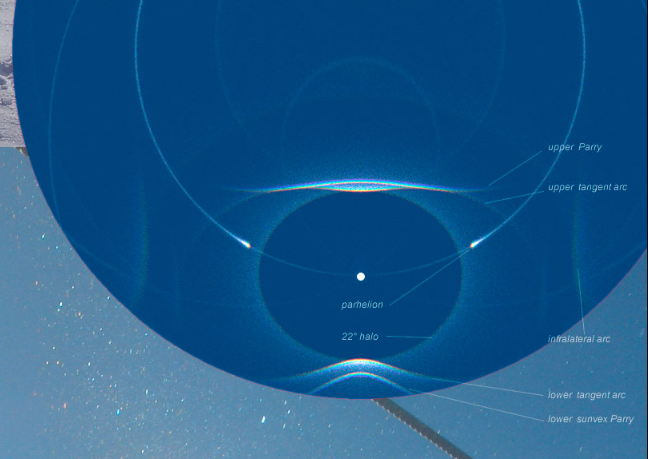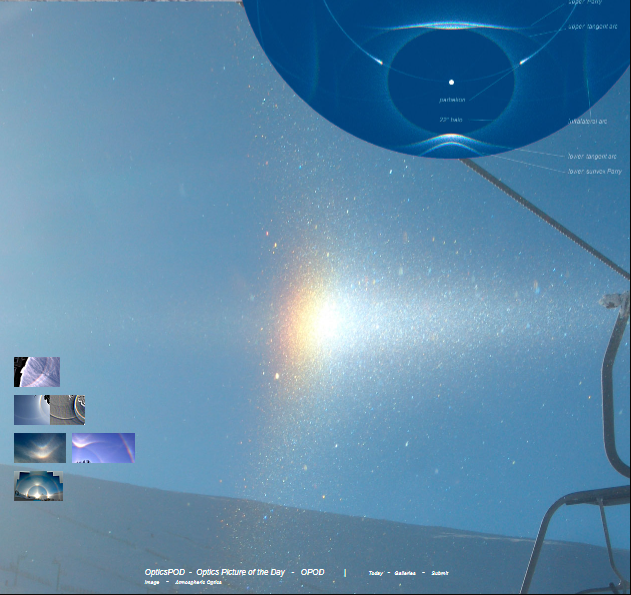OPOD - Spain Diamond Dust Halos
OPOD - Spain Diamond Dust Halos: A Mesmerizing Display of Atmospheric Optics
In the realm of atmospheric optics, nature often gifts us with captivating displays that leave us in awe of its beauty and complexity. One such remarkable phenomenon is the occurrence of diamond dust halos, which was beautifully captured by photographer Miguel Pérez Ayúcar at Valdesqui in the Madrid Sierra of Spain on February 1st, 2011.
An Enchanting Encounter with Diamond Dust Halos
Miguel Pérez Ayúcar found himself in a unique vantage point, situated above a cloud deck in the valley. As he looked down, he witnessed a mesmerizing sight - a cloud layer moving up the side of the mountain towards him, accompanied by a multitude of ice crystals carried by the uphill wind. This fortuitous combination set the stage for an extraordinary display of atmospheric optics.
A Kaleidoscope of Optical Phenomena
As the ice crystals filled the air, they became the canvas upon which light could create stunning optical effects. The resulting display was a symphony of intricate halos and arcs, each with its own distinct characteristics. Miguel Pérez Ayúcar was able to capture the following phenomena with great detail:
- The 22-degree halo: A circular halo encircling the sun or moon at an angle of approximately 22 degrees. It is formed by the refraction and reflection of light within hexagonal ice crystals suspended in the atmosphere.
- Parhelia: Also known as sun dogs, these bright spots appear on either side of the sun and are caused by the refraction of sunlight through plate-shaped ice crystals.
- Upper tangent and lower tangent arcs: Arcs that touch the top and bottom of the 22-degree halo, respectively, created by sunlight interacting with horizontally oriented ice crystals.
- Circumzenithal arcs: Curved arcs that appear above the sun, forming an upside-down rainbow-like shape. These arcs result from the refraction and reflection of sunlight within randomly oriented ice crystals.
- Parhelic circle: A complete circle of light passing through the sun and parhelia, caused by the reflection of sunlight from plate-shaped ice crystals.
- Supralateral arc: An arc that extends above the 22-degree halo, formed by the refraction and reflection of sunlight through horizontally oriented ice crystals.
- Infralateral arc: A vividly colorful arc located below the 22-degree halo, resulting from the refraction and reflection of sunlight within randomly oriented ice crystals.
- Lower sunvex Parry arc: A shiny white arc situated below the parhelia, formed by the refraction of sunlight through column-shaped ice crystals.
Unveiling the Secrets with HaloSim Ray Tracing
To further understand the intricate dance of light and ice crystals, HaloSim ray tracing was employed. This simulation allowed scientists to recreate the approximate solar altitude during the display and explore the presence of a third elusive Parry arc. The findings revealed the existence of this additional arc, adding another layer of complexity to an already awe-inspiring phenomenon.
A Deeper Dive into Diamond Dust Halos
Diamond dust halos are not exclusive to Spain; they can occur in various cold regions around the world, where temperatures are low enough for ice crystals to form in the air. These halos often grace polar regions, high-altitude mountainous areas, and even places with extremely cold winter climates.
The formation of diamond dust halos relies on a delicate interplay between sunlight and ice crystals. As sunlight passes through these microscopic crystals suspended in the atmosphere, it undergoes refraction, reflection, and dispersion. The specific shapes and orientations of the ice crystals dictate the unique patterns and colors observed in diamond dust halos.
The Magic of Atmospheric Optics
Atmospheric optics never fails to amaze us with its captivating displays of natural beauty. Diamond dust halos, like the one witnessed in Spain, are a testament to the intricate and mesmerizing interactions between light and ice crystals in our atmosphere. Each halo and arc tells a story of the physics behind their formation, revealing the secrets of nature's artistic prowess.
So, the next time you find yourself gazing at the sky on a cold winter day, keep an eye out for these enchanting diamond dust halos. They serve as a reminder of the boundless wonders that exist in the world around us, waiting to be discovered and appreciated.

Spain Diamond Dust Halos
Images by Miguel Pérez Ayúcar at Valdesqui, in the Madrid Sierra of Spain 1st February '11.
©Miguel Pérez Ayúcar, shown with permission.

" We were at the upper part of the Valdesqui mountain area. There was a cloud deck below us in the valley and moving up over the side of the mountain towards us. The wind was blowing uphill bringing a plethora of ice crystals.
We could see the 22deg halo, the parhelia, upper tangent, lower tangent and circumzenithal arcs with great detail. But also very neat the parhelic circle all around us, and a supralateral arc.
Then a bright colorful infralateral arc, the most colorful of all. And the lower sunvex Parry arc in shiny white! Fantastic."

HaloSim ray tracing for the approximate solar altitude of the display.
There is a third elusive Parry arc in the simulation.

Note: this article has been automatically converted from the old site and may not appear as intended. You can find the original article here.
Reference Atmospheric Optics
If you use any of the definitions, information, or data presented on Atmospheric Optics, please copy the link or reference below to properly credit us as the reference source. Thank you!
-
<a href="https://atoptics.co.uk/blog/opod-spain-diamond-dust-halos/">OPOD - Spain Diamond Dust Halos</a>
-
"OPOD - Spain Diamond Dust Halos". Atmospheric Optics. Accessed on April 25, 2024. https://atoptics.co.uk/blog/opod-spain-diamond-dust-halos/.
-
"OPOD - Spain Diamond Dust Halos". Atmospheric Optics, https://atoptics.co.uk/blog/opod-spain-diamond-dust-halos/. Accessed 25 April, 2024
-
OPOD - Spain Diamond Dust Halos. Atmospheric Optics. Retrieved from https://atoptics.co.uk/blog/opod-spain-diamond-dust-halos/.